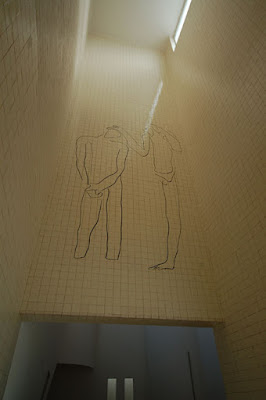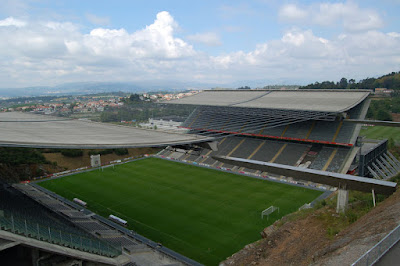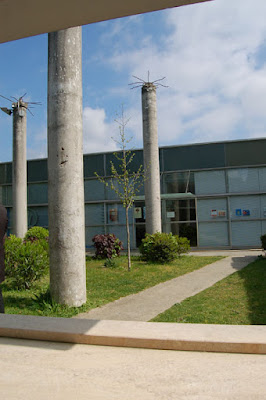When I reached by friend Paulo’s house in Porto he told me that he had some free time during the weekend and could drive me around to show me some buildings that might otherwise be quiet difficult to get to. Little did I know that he was planning to show me almost every significant building designed by Alvaro Siza and Eduardo Souto de Moura in northern Portugal!
Early on Saturday we set off on one of most intense architectural day trips I have ever attempted. We started by heading off to the small city of Marco de Canaveses where we saw the Church of St Mary by Siza. Since I know how miserably I will fail at trying to write about this blissful piece of architecture, I will resort to only sharing photos of it –
Early on Saturday we set off on one of most intense architectural day trips I have ever attempted. We started by heading off to the small city of Marco de Canaveses where we saw the Church of St Mary by Siza. Since I know how miserably I will fail at trying to write about this blissful piece of architecture, I will resort to only sharing photos of it –

.jpg)
.jpg)
.jpg)
.jpg)
.jpg)
.jpg)
.jpg)
.jpg)
.jpg)
.jpg)
.jpg) The next stop was to one of the most important cities of northern Portugal - Braga; here we saw two projects designed by Souto de Moura.
The next stop was to one of the most important cities of northern Portugal - Braga; here we saw two projects designed by Souto de Moura. The Braga Municipal stadium – unlike most contemporary stadiums which are cut-off from their contexts, this one has an amazing relationship with its surroundings.

.jpg) The football stadium that is cut in to the northern slope of Monte Castro sits much like the great amphitheatres built by the Greeks and Romans into the Mediterranean hills.
The football stadium that is cut in to the northern slope of Monte Castro sits much like the great amphitheatres built by the Greeks and Romans into the Mediterranean hills..jpg) (check some drawings of this project here)
(check some drawings of this project here)The other project by Souto de Moura in the city was the civic market designed between 1980-84 much like an ancient Greek stoa, but after a few years of use the market closed down and the project lay abandoned. That is until the city decided to convert it into a cultural facility (with some classrooms, dance studio etc.). They then asked Souto de Moura to rework his market to fit a new brief – this gave rise to a project that I consider to be his most interesting project yet.
 He decided to modify quiet a bit of his original design, but does this with extreme maturity. He decides to remove as much as possible of the main hall of the market so as to make room for a long patio garden but decides to leave enough of it to be able to read its past - treating it almost like an ancient ruin.
He decided to modify quiet a bit of his original design, but does this with extreme maturity. He decides to remove as much as possible of the main hall of the market so as to make room for a long patio garden but decides to leave enough of it to be able to read its past - treating it almost like an ancient ruin.
.jpg)
.jpg) Half the project that has been completed so far is a quasi-excavation site, apparently laying bare the remnants of a great settlement, now once again occupied by the appreciative citizens of Braga. Souto de Moura fuses his awe for ancient cities (his experiences of walking thru the great ruins of the Roman forum) with the bare power of more contemporary abstraction.
Half the project that has been completed so far is a quasi-excavation site, apparently laying bare the remnants of a great settlement, now once again occupied by the appreciative citizens of Braga. Souto de Moura fuses his awe for ancient cities (his experiences of walking thru the great ruins of the Roman forum) with the bare power of more contemporary abstraction.
.jpg) Next we headed for Viana do Castelo, a coastal city located at the mouth of the Rio Lima. In recent years the city has seen a flurry of building, designed by some of the most important architects in the country – making it a haven for architectural tourists.
Next we headed for Viana do Castelo, a coastal city located at the mouth of the Rio Lima. In recent years the city has seen a flurry of building, designed by some of the most important architects in the country – making it a haven for architectural tourists.
 He decided to modify quiet a bit of his original design, but does this with extreme maturity. He decides to remove as much as possible of the main hall of the market so as to make room for a long patio garden but decides to leave enough of it to be able to read its past - treating it almost like an ancient ruin.
He decided to modify quiet a bit of his original design, but does this with extreme maturity. He decides to remove as much as possible of the main hall of the market so as to make room for a long patio garden but decides to leave enough of it to be able to read its past - treating it almost like an ancient ruin..jpg)
.jpg) Half the project that has been completed so far is a quasi-excavation site, apparently laying bare the remnants of a great settlement, now once again occupied by the appreciative citizens of Braga. Souto de Moura fuses his awe for ancient cities (his experiences of walking thru the great ruins of the Roman forum) with the bare power of more contemporary abstraction.
Half the project that has been completed so far is a quasi-excavation site, apparently laying bare the remnants of a great settlement, now once again occupied by the appreciative citizens of Braga. Souto de Moura fuses his awe for ancient cities (his experiences of walking thru the great ruins of the Roman forum) with the bare power of more contemporary abstraction..jpg) Next we headed for Viana do Castelo, a coastal city located at the mouth of the Rio Lima. In recent years the city has seen a flurry of building, designed by some of the most important architects in the country – making it a haven for architectural tourists.
Next we headed for Viana do Castelo, a coastal city located at the mouth of the Rio Lima. In recent years the city has seen a flurry of building, designed by some of the most important architects in the country – making it a haven for architectural tourists. The city has new promenade designed by Adalberto Dias (a protégé of Siza)
 on which sits two building designed by Fernando Távora and Municipal library by Siza.
on which sits two building designed by Fernando Távora and Municipal library by Siza.
Here are a few images of the Távora project:
.jpg)
.jpg) And some images of the library by Siza:
And some images of the library by Siza:

.jpg)
.jpg)
.jpg)
.jpg)
.jpg)
.jpg)
.jpg)
.jpg) After that we went to see a youth hostel designed by the famous Lisbon architect – Joao Luis Carrilho Da Graca.
After that we went to see a youth hostel designed by the famous Lisbon architect – Joao Luis Carrilho Da Graca.

.jpg)
.jpg)
.jpg)
 on which sits two building designed by Fernando Távora and Municipal library by Siza.
on which sits two building designed by Fernando Távora and Municipal library by Siza.Here are a few images of the Távora project:
.jpg)
.jpg) And some images of the library by Siza:
And some images of the library by Siza:
.jpg)
.jpg)
.jpg)
Above - furniture in the children's section.
.jpg)
.jpg)
Like in most other projects by Siza here too all the furniture, door handles etc are designed by the Master architect.
.jpg)
.jpg)
.jpg) After that we went to see a youth hostel designed by the famous Lisbon architect – Joao Luis Carrilho Da Graca.
After that we went to see a youth hostel designed by the famous Lisbon architect – Joao Luis Carrilho Da Graca. 
.jpg)
.jpg)
.jpg)
And as we left the city we drove past the Axis hotel designed by Jorge Albuquerque (from an architectural firm called VHM). Sadly, this project was far below par of the great architecture that we saw all day!


We had one last halt to make on our way back to Porto, at the small city of Vila do Conde where we stopped to see the Borges & Irmao bank.

.jpg) Of all the projects by Siza I have seen thus far on this trip this was the smallest and most fluid.
Of all the projects by Siza I have seen thus far on this trip this was the smallest and most fluid..jpg)
.jpg)
No comments:
Post a Comment